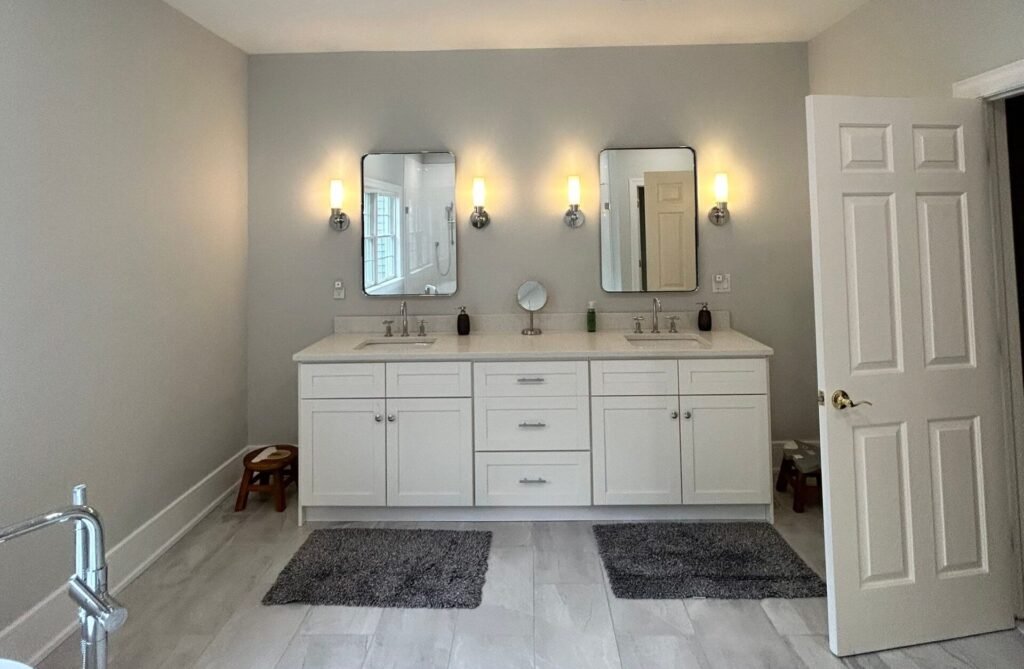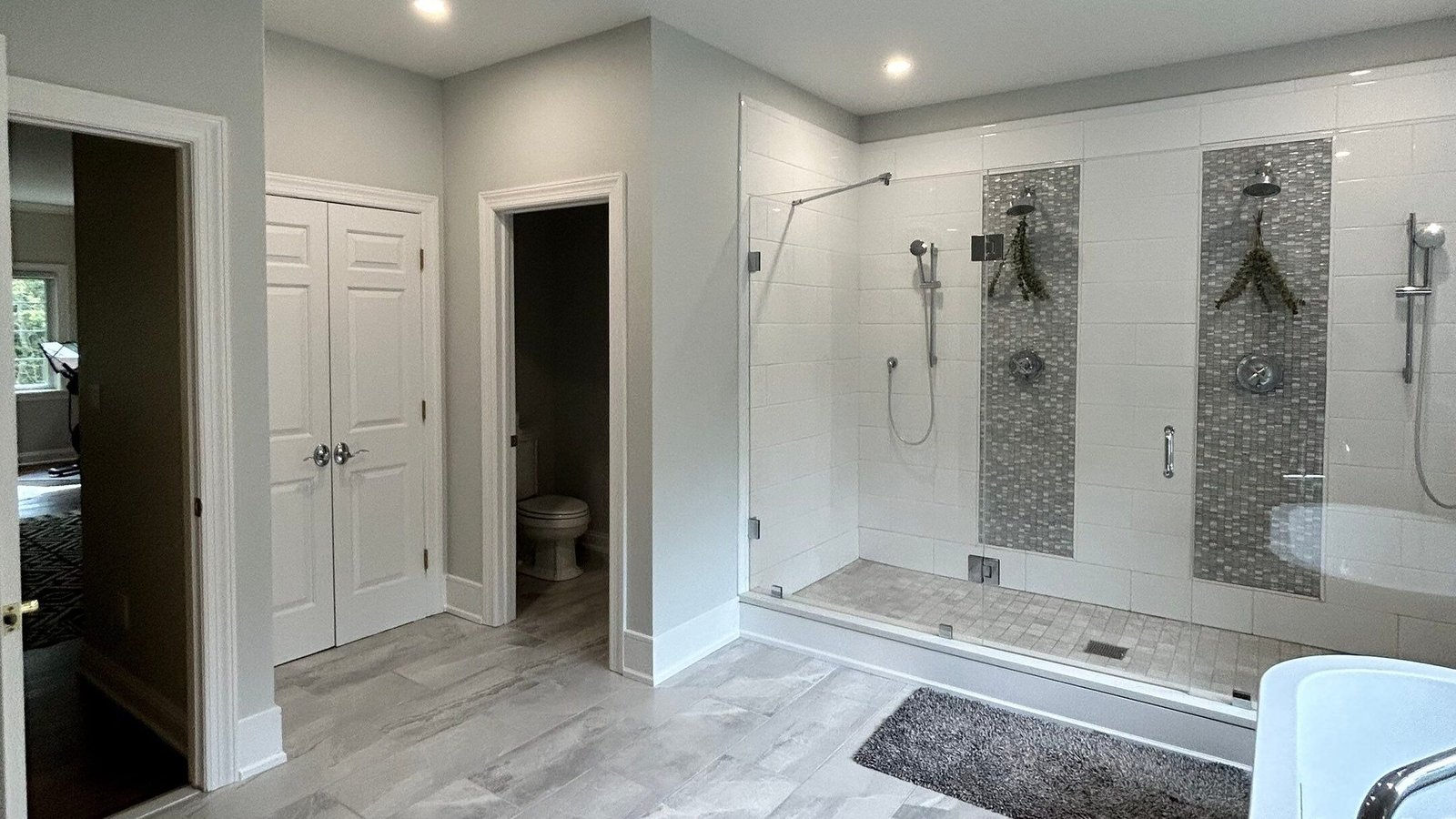Painting a bathroom presents unique challenges due to its high-moisture environment, frequent temperature fluctuations, and often limited ventilation. Choosing the right type of paint, not just the color, is crucial for preventing common issues like mildew growth, peeling paint, and bubbling. Genesis Pro Painting guides U.S. homeowners through selecting the best finishes and formulas to ensure your bathroom walls look beautiful and stand up to the demands of daily use.

Why moisture matters in bathrooms
Moisture is the primary enemy of bathroom paint. Here’s why it’s a critical factor in your paint choice:
- Mildew and Mold Growth: Constant humidity provides an ideal breeding ground for mildew and mold spores, which thrive on organic materials (like paint ingredients) in damp conditions. These appear as black, green, or brown spots on walls and ceilings.
- Peeling and Blistering Paint: When paint absorbs moisture, it can lose adhesion to the surface. This leads to bubbling, cracking, and ultimately, peeling, especially in areas directly exposed to water or steam (e.g., near showers, tubs).
- Deterioration of Substrate: Persistent moisture can penetrate through compromised paint layers, leading to damage of the drywall, plaster, or wood underneath, potentially causing structural issues or requiring extensive repairs.
- Odor and Air Quality: Mildew and mold not only look bad but also produce a musty odor and can release spores into the air, impacting indoor air quality and potentially affecting those with allergies or respiratory issues.
Using paints formulated for high-moisture environments creates a durable barrier that resists these common bathroom problems.
Water-based acrylic/styrene-acrylic for walls
For general bathroom walls and ceilings, modern water-based paints are generally the best choice, specifically those with acrylic or styrene-acrylic binders.
- Acrylic Latex (100% Acrylic): These paints offer superior flexibility, adhesion, and resistance to cracking and fading. They are highly durable and retain color well.
- Styrene-Acrylic Latex: Often found in specialized bathroom or kitchen paints, the addition of styrene enhances the paint’s hardness, scrubbability, and resistance to moisture and humidity, making it even more robust for demanding bathroom environments.
- Key Advantages for Bathrooms:
- Mildew Resistance: Many modern acrylic latex paints for bathrooms contain mildewcides (mold-inhibiting additives) that actively resist mildew growth.
- Washability and Durability: They dry to a tough film that can withstand frequent washing and cleaning without losing integrity.
- Flexibility: They expand and contract with temperature changes, reducing the likelihood of cracking and peeling in areas with fluctuating humidity.
- Low VOCs and Odor: Water-based paints are lower in Volatile Organic Compounds (VOCs), meaning less odor during application and drying, which is beneficial in a small, enclosed space like a bathroom.
- Avoid Vinyl Acrylics: While generally good for living spaces, standard vinyl acrylic paints (which are more common in less expensive interior paints) may not offer sufficient mildew resistance or washability for high-moisture bathroom walls. Look for “100% acrylic” or “kitchen and bath” specific formulations.
Matte/flat okay with proper ventilation and premium brands
Traditionally, flat or matte finishes were discouraged in bathrooms due to their porous nature, which made them prone to absorbing moisture and growing mildew. However, modern paint technology has changed this.
- Premium Matte/Flat Formulas: Many high-quality paint brands now offer premium “matte” or “flat” finishes (sometimes called “washable flat” or “scrubbable matte”) that are engineered with advanced resins and mildewcides. These formulas create a very tight, non-porous film that resists moisture absorption and is surprisingly durable and washable.
- Aesthetic Appeal: Matte finishes offer a sophisticated, contemporary look that conceals wall imperfections better than shinier finishes.
- Crucial Condition: Ventilation: If you choose a matte or flat finish, it is imperative to have excellent ventilation in your bathroom. This means a powerful exhaust fan that is used during and after showers/baths, and potentially a window that can be opened. Without proper ventilation to remove moisture, even premium matte paints may eventually succumb to mildew or moisture issues in consistently damp conditions.
- Consider for: Ceilings (where flat is almost always preferred to hide imperfections) and walls in bathrooms with good ventilation and less direct water exposure.
Semi-gloss (or satin) for trim, doors & wet zones
Shinier finishes provide superior durability and moisture resistance, making them ideal for high-contact areas and “wet zones.”
- Semi-Gloss: This finish is highly durable, very washable, and resistant to moisture and mildew. Its smooth, hard surface makes it easy to wipe clean.
- Best For:
- Trim and Doors: Handles frequent touching and cleaning, resisting scuffs and fingerprints.
- High-Splash Areas (Wet Zones): The immediate areas around sinks, toilets, showers, and bathtubs, where direct water splashes or heavy condensation is common. While tile is often used here, if painting, semi-gloss provides the best protection.
- Best For:
- Satin (or Eggshell): A slightly less glossy alternative to semi-gloss, offering a soft sheen that’s still very durable and washable. It’s a popular compromise for walls that need more protection than flat but less shine than semi-gloss.
- Best For: Walls in bathrooms with moderate moisture, or for those who find semi-gloss too shiny for large wall areas. Offers a good balance of washability and aesthetic.
Why Shinier Finishes Excel in Bathrooms: The higher resin content in satin and semi-gloss paints creates a tighter, harder, and less porous film, making them inherently more resistant to moisture penetration and easier to clean when mildew or splashes occur.
Oil-based enamel for cabinets & trim
While water-based paints have improved significantly, oil-based (alkyd) enamels still hold an advantage for certain applications in a bathroom due to their inherent hardness and leveling properties.
- Oil-Based Enamel (Alkyd): Dries to an exceptionally hard, smooth, and durable finish. It levels out beautifully, leaving minimal brush marks, which is highly desirable for fine finishes.
- Best For:
- Bathroom Cabinets: Provides a furniture-quality, highly durable finish that withstands frequent cleaning, moisture, and daily wear and tear.
- Vanities & Built-ins: Similar to cabinets, their hard finish holds up well.
- High-Touch Trim (Optional): For very high-traffic trim pieces that receive constant abuse and where maximum chip resistance is desired.
- Considerations: Higher VOCs and stronger odor, slower drying time, and requires mineral spirits for cleanup. However, once cured, the durability is unparalleled for these specific applications.
- Alternative: If low VOCs and quicker dry time are paramount, modern water-based acrylic-alkyd hybrid enamels are an excellent alternative. They offer many benefits of oil-based paints (hardness, leveling) with the easy cleanup and lower VOCs of water-based paints.
- Best For:

Prep & ventilation best practices
Proper preparation and ensuring good ventilation are fundamental, regardless of the paint type.
Surface preparation:
- Clean Thoroughly: Before painting, wash all surfaces with a mild detergent (like TSP substitute) to remove soap scum, grime, and mildew. Rinse thoroughly and allow to dry completely.
- Mildew Removal: If existing mildew is present, scrub the area with a solution of 1 part bleach to 3 parts water. Rinse and allow to dry completely.
- Repair Imperfections: Patch any holes or cracks with spackle designed for damp environments. Sand smooth.
- Prime Stains/Bare Spots: Use a high-quality, stain-blocking primer on any water stains, patched areas, or bare drywall. If you had significant mold/mildew, a primer with mildewcide is beneficial.
- Sand Glossy Surfaces: Lightly sand glossy trim or cabinets to create a “tooth” for adhesion.
Ventilation during painting:
- Exhaust Fan: Run the bathroom exhaust fan constantly during painting and for several hours afterward.
- Open Windows/Door: Keep windows (if applicable) open and the bathroom door ajar to promote airflow.
- Fans: Use additional box fans to circulate air and help dry the paint more quickly.
Ventilation after painting & daily use:
- Consistent Fan Use: Always use the exhaust fan during and for at least 15-20 minutes after showers or baths to remove moisture.
- Wipe Down: If condensation is heavy, quickly wipe down shower walls and other surfaces after use.
- Humidity Control: Consider a dehumidifier in highly humid climates if necessary.
By following these guidelines, U.S. homeowners can ensure their bathroom painting project results in a beautiful, durable, and mold-resistant finish that lasts for years.
Is your bathroom paint failing the moisture test? Genesis Pro Painting specializes in selecting and applying the perfect paints for high-humidity environments, ensuring a flawless, mildew-resistant finish that lasts. Contact us today for expert advice and a professional paint job in your U.S. home!
